With the discussion of topics related to Tamil political, social and cultural aspects, the lush history of Tamil literature extends over more than 2000 years. As a Tamil woman myself, I feel the need to indulge in the great and diverse works of my ancestors. From classics to modern literature, every period in Tamil literature includes a diversity of enrichment that is ultimately a work of art to be admired for years to come.
Tamil literature consists of five main periods:First, the Sangam age; second, the Post-Sangam period; third, medieval literature; fourth, the period Vijayanagar and Nayak; and finally, modern times.
Sangam age
The Sangam period is a historical era of Tamil literature, stretching from the 6th century BCE to the 3rd century AD. Alas, most of the works from this period have not survived. The oldest known surviving piece of literature is the Eighteen Greater Texts, often known in Tamil as Patiṉeṇmēlkaṇakku.
The eighteen Greater Texts date back between 100 BC and 200 AD. They include the ten idylls (Pattupattu) and eight anthologies (Ettuthokai). This literary work contains approximately 2831 poems attributed to 473 poets.
One of the most significant literary works of this period that is still discussed among Tamil people today is Silappatikāram , which is among one of the five great epics in Tamil literature: Silappatikāram , Manimekalai , Cīvaka Cintāmaṇi , Valayapathi and Kuṇṭalakēci .
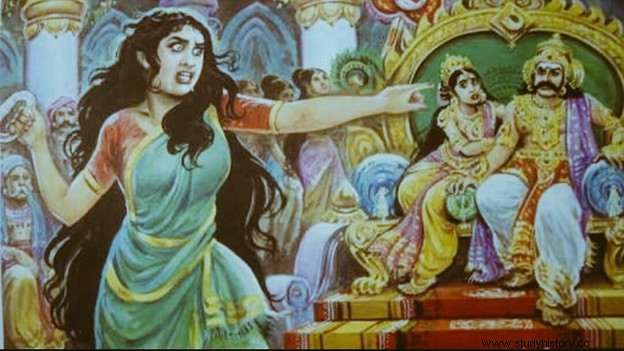
Silappatikāram
Dating back to the 5th - 6th century AD, the epic Silappatikāram highlights the heartbreaking affair between Kannagi and Kovilan through a poem containing 5740 lines. The epic depicts the story of Kannagi and Kovalan, newlyweds who live happily in harmony. As the story unfolds, Kovalan leaves his wife for another woman, Madhavi, and spends all his money on her.
Despite her husband's infidelity, Kannagi is waiting for Kokilan to return. At Indra's festival (a festival for the goddess of rain), Madhavi and Kovalan participate in a singing competition. Kovalan's song contains lyrics about a man who is hurt by his lover, while Madhavi's song depicts a man who has betrayed his relationship. These songs eventually make them separate, prompting Kanaggi to accept Kovilan's return.
When Kokilan is in debt, he sells Kannagi's ankle to a jeweler, without knowing that the jeweler will hit him for stealing the queen's ankle. He is then executed by the king without being able to prove his innocence. When Kannagi finds out about this, she looks with anger as she goes to court to interrogate the king. She shows the king the other ankle that belongs to her, and then tears her chest and throws it at the city of Madurai, eventually burning it down with the curse and killing the king in the process, as the shame is so unbearable that he commits suicide.

Kannagi is often portrayed as a symbol of chastity in Tamil culture due to the extent she has gone through to demonstrate her loyalty to her husband, despite his mistakes. She is worshiped as a goddess in selected parts of South Asia.
T olkāppiyam
Although the dating of Tolkāppiyam is difficult to mark, it is proposed to date back between 5,320 BC and the 8th century AD. It is one of the most important works in Tamil literature, as it allows for an understanding of the origins of the Tamil language.
Tolkāppiyam consists of three books:word (Eluttatikaram), sounds (Sollatikaram), and topic (Porulatikaram). Tolkāppiyam contains important topics in accordance with Tamil history:
on Tolkāppiyam and the anthologies, poems are classified by theme in akam ("Interior") and puṟam ("Exterior"), the formerly highly structured love poems, the latest heroic poems about war, death, personal virtues, the cruelty and honor of kings and the poverty of poets.
This textual work highlights the aspects of ancient Tamil culture in a poetic sense. It also goes into depth about the nature of South Asia, with descriptions of five landscapes considered important in the Sangam culture, and their content.
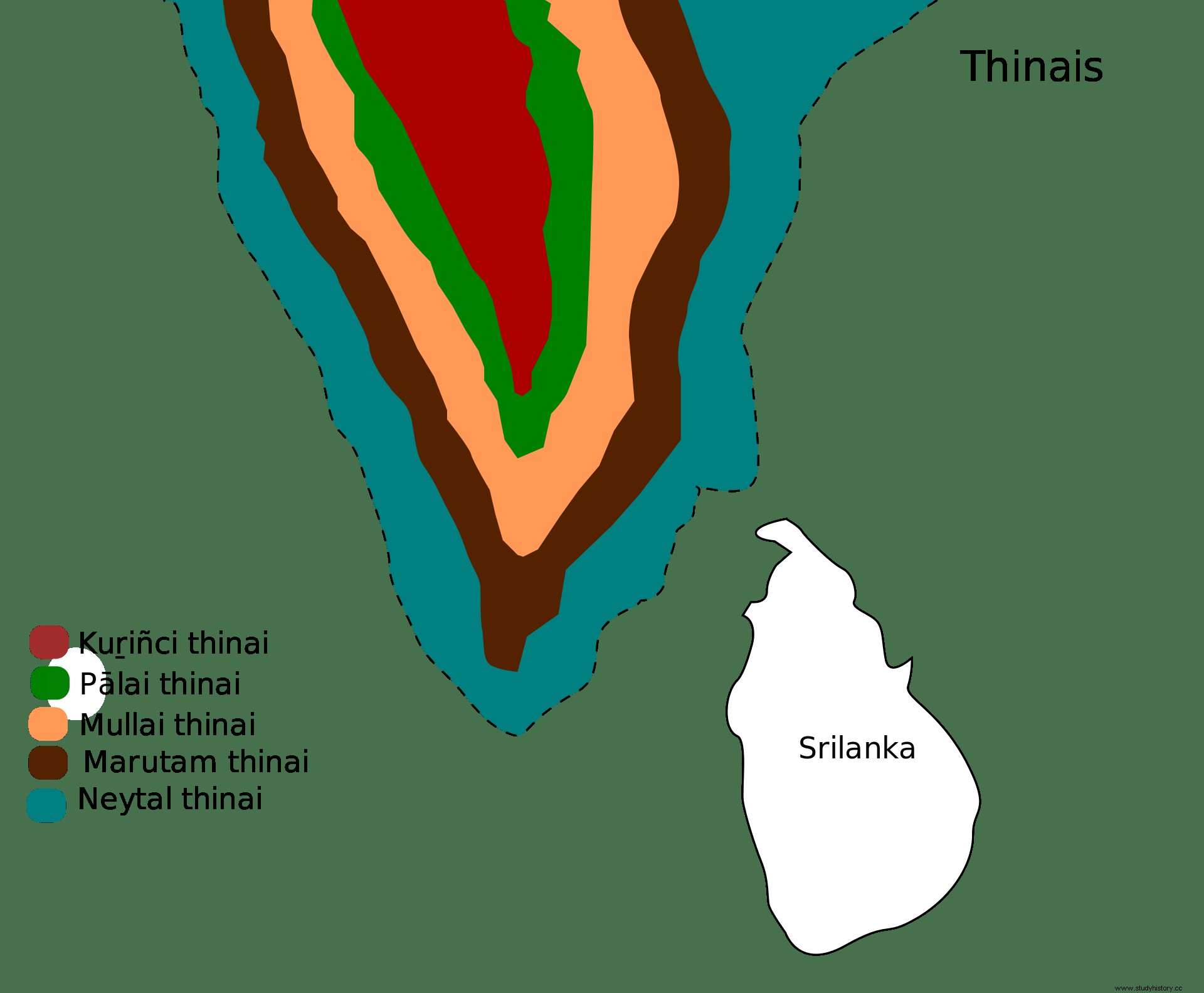
These five landscapes include Kurinji (mountain region), Mullai (forests), Marutham (cultivated land), Neithal (coast) and Pālai (arid lands). The poems by depicting these landscapes we can understand the importance of nature in ancient Tamil culture. Such poems call for a clear perspective on the beauty of nature. As seen below, there is a poem translated into English that depicts Neithal:
Water lilies bloom
in the lagoons
where taps share water lilies
looking for fish
then fly away to stay
in fragrant groves by the sea,
near my lover's village washed by the sea.His love for me
is larger than the ocean.—Neithal (Ainkurunuru-184)
The Sangam period continues to be of great importance in Tamil literature, as it emphasizes the experiences of the first known and recorded emergence of Tamil people.
Post-Sangam period of Tamil literature
The post-Sangam period occurred about three centuries after the Sangam age. With this period came literature related to philosophy and ethics in Tamil culture. The most prominent text on ethics comes from this age, Tirukkural of Thiruvalluvar. It is divided into 133 sections and contains short links of seven words.

Tirukkural has three sections: a weather (virtue), porul (government and society), and kamam (love). Emphasis is placed on ideas of gratitude, kindness, non-violence and more. It is mainly seen as a text of the moral code of Tamil literacy. Below are some examples of Tirukkurals :
Even if you have nectar that will ensure immortality,
it is not noticeable to eat alone, so guests are out. (82)Do not call him a man, one who speaks
vain words; he is a scum. (196)The wealth of the wise man who loves, and is loved by, the world,
is like a public pond full of water. (215)
As seen in these examples, Thiruvalluvar's words were written to encourage Tamil people to behave morally. His views on ethics still play a major role in Tamil culture today, as hospitality is still a major part of Tamil culture.
Medieval Tamil literature
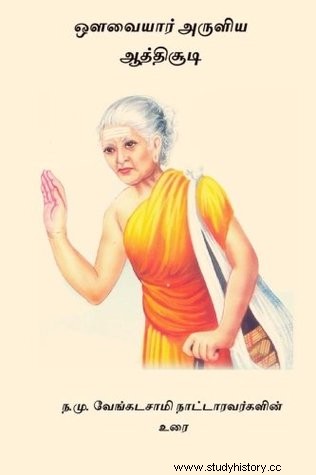
The Middle Ages, dating from the 11th and 13th centuries, were a harmony among Tamil people. Avvaiyar, a female poet whose name translates to 'respectable woman', created poems during this era that continue to be taught in Tamil schools today. Avvaiyar is one of the most crucial poets in Tamil history, as her poems appeal to children. Her famous poem, Aathichoodi, demonstrates to children how to live a life full of moral authenticity using the Tamil alphabet. Below are some lines from the poem translated into English:
Intends to do the right deeds,
The nature of the mind must diminish,
Help others as much as you can,
Do not stop or avoid charitable deeds,
Do not brag about your possessions - wealth, skills, knowledge, etc ...
Never lose hope or motivation,
Do not despise numbers and letters (mathematics, or art, science and literature),
Do not be silent,
Give alms, then eat,
Adapt to your changing world,
Never stop learning,
Do not speak ill of others (especially behind your back),
Do not hinder development or creativity.
Tamil literature up to this period includes a common theme of moral lessons and 'words to live by' to guide people to live ethical lives.
Vijayanagar and the Nayak Period
The Vijayanagar and Nayak periods, which ruled from about 1300 to 1650 AD, were a period in Tamil history in which the Tamil country would be affected by an invasion, and eventually conquered. As a result, there was the rise of the Vijayanagar Empire and Nayak rule. Examples of works in Tamil literature were still produced in this era. For example, Thiruppugazh by Arunagirinathar.
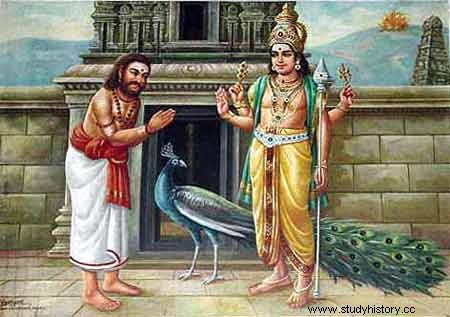
Thiruppugazh
Thiruppugazh , created in the 15th century, is a work of religious songs praising Lord Murugan. The background behind Arunagirinathar's justification for writing Thiruppugazh is quite exciting. According to Arunagirinathar, Lord Murugan saved him when he was about to end his life on a temple. Ultimately, this reformed his life. Consequently, Arunagirinathar decides to make devotional songs to thank Lord Murugan for saving him. An example of this is demonstrated in these verses:
O Lord of heaven
which protects the Kurava woman from the sweet, child-like words
who uses the spear that destroyed the majestic ground
and bears a wreath of scarlet blue flowers
where bees dance and seek honey. (Song 1304)
This period demonstrated the devotion to religion prominently, especially with the use of literature. As seen through this article, the Hindu religion is prominently valued among Tamil people.
The modern age of Tamil literature
The end of the 18th to the 19th century brought the modern era in Tamil literature. This gave us the works of Subramanya Bharathi, who was an author and an important member in social reform. Bharathi was very influential, both with his literature and activism.

Bharathi's work is often cited as the inspiration for modern Tamil literature. His work is said to involve both modernist and classical techniques. In addition, his poems show how outspoken he was on social issues, and often show rebellious comments. Bharathi covered a variety of themes in his works, from children's songs to praising those who fought for India's independence. Here is Bharathi's comment on the Indian castle system:
There is no caste system.
It's a shame to share people on a caste basis.
Those who are truly of a superior class are they
excelled in being fair, wise, educated and loving.
Bharathi would eventually be sent into exile later in life, after being exposed for his involvement in extremism in the Indian National Congress. He remains an influence on the works we see today, and serves as a great inspiration for poets such as Bharathidasan.
Modern times played a major role in the revolt of the British and French colonizers, and caused many of those who criticized the colonizers to go into exile. Furthermore, they were still praised by Tamil people, as these authors were seen as representations of social reform and unity among South Asians.
The Emergence of Tamil Novels
The modern age of Tamil literature was accompanied by an increase in novels. Ramanichandaran would contribute to this rising trend with the composition of modern romantic novels of the 20s. She is currently the best-selling author in Tamil literature, with 178 novels written.
Ramanichandran's focus on romantic novels does not include the idea of caste systems, which is a common controversy in South Asia because the caste system is still used to this day.
One of her famous books, Kanney Kanmaniey, illustrates Madura and her boyfriend, Sathyan. Madura's brother loses money while betting on horses, which makes her and her brother work at Sathyan's hotel. Sathyan subconsciously believes that Madura betrayed him and ends up marrying another woman, but his wife ends up dying. Conflicting with revenge and immortal love, Sathyan is confused about how to act towards Madura. In sum, the story follows Sathyan's journey of love and finding out his feelings towards Madura.
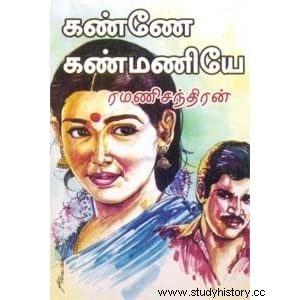
As a result, this type of story is very popular among Tamil women because it allows them to live through these stories.
Cultural and linguistic significance in anthropology
Tamil, one of the oldest recorded languages in linguistic history, has a diverse literature library. With comments on ethics and struggle, to songs that depict the beauty of nature before the rise of the demolition of the environment, Tamil literature gives us a deep insight into the values of South Asian culture. Some of these values are still considered today. In retrospect, the Tamil people were apparently advanced in thought and transcribed it into literature. The exploration of this language provides a better understanding of the Tamil culture and its customs.
In addition, there is linguistic significance when looking at the history of Tamil literature as well. Although most, if not all, of the literature from the 6th century BCE is not today, it is still clear that the Tamil people took the time to register their thoughts. The Tamil ancestors decided that their language was important enough for them to document. It is as if they knew that future generations would like and expand this language. This documentation allows them to learn the language today, with many references available for expanding knowledge.
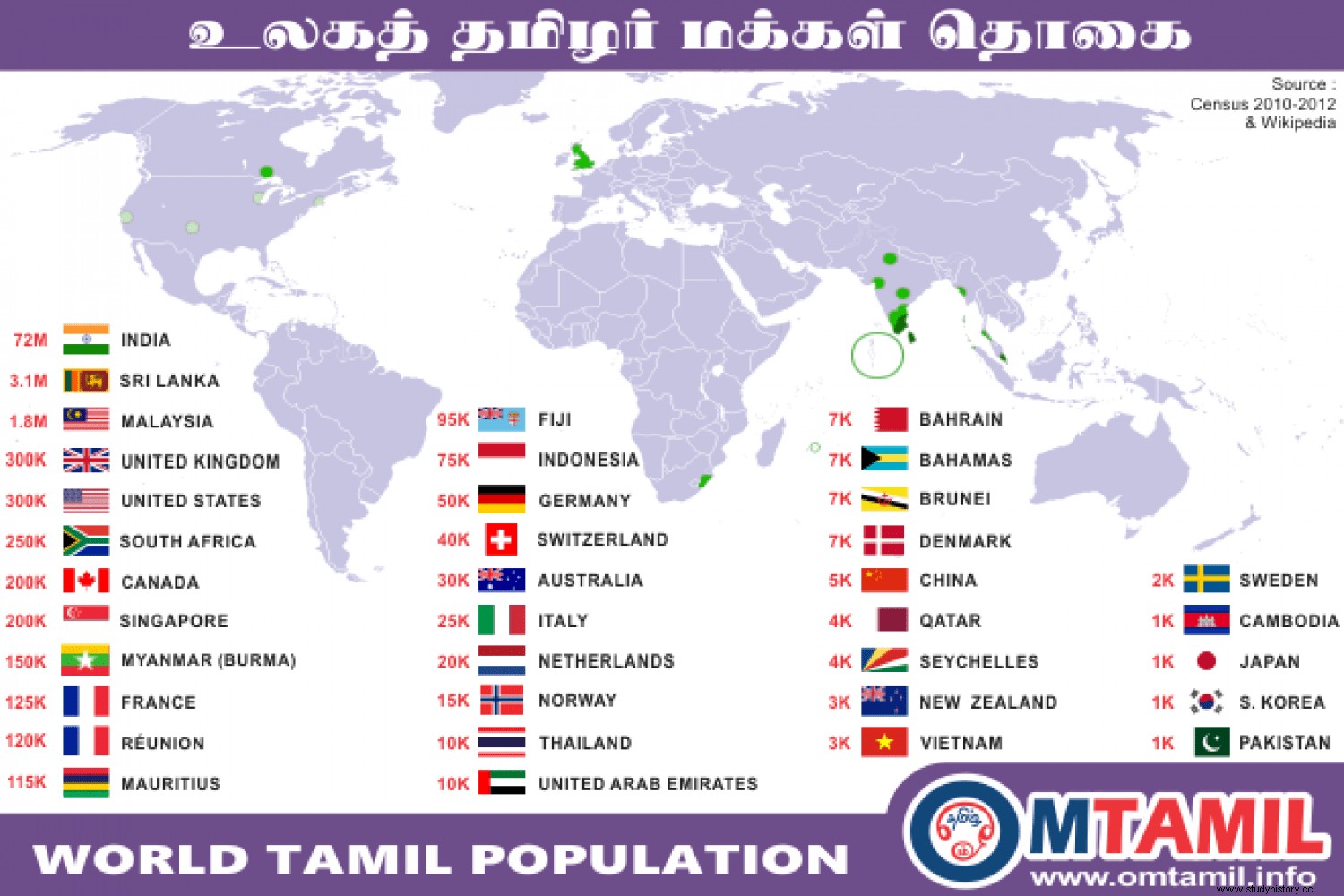
Result of expanding language
As a result of this willingness to expand the language and continue the culture, approximately 76 million people belong to the Tamil population. With technological advances in modern society, we can access the ideas that generations from more than 2000 years ago, observe how they have shaped our society. Therefore, with the documentation of the Tamil language, we can understand that:
Tamil is one of the few living classical languages and has an unbroken literary tradition of over two millennia. The high level of diglossia displayed by Tamil, and the prestige that classical Tamil has given, have resulted in much of the vocabulary and forms of classical Tamil being preserved in modern literary Tamil, so that the higher registers of literary Tamil have a tendency to the classical language. The classical language is also an important part of Tamil-medium education:verses from Tirukkural, a classical work, for example, are taught in primary school. The common form of modern language used in speech and writing, on the other hand, has undergone significant changes, to the extent that a person who has not learned the higher literary form will have difficulty understanding it.
source
With 247 characters in the language, Tamil literature can depict the complexity of the language through its literary works.
